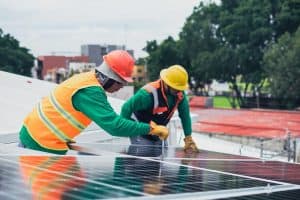
There’s no denying that solar is going to be a part of our future. It’s the most cost-effective way to create electricity, and it’s completely green. The sun shines bright every single day, which means that you can feel the benefits on a daily basis.
However, before starting an installation in your home, you need careful planning and calculation to determine exactly how many panels you need and where to place them. Here are some of the things that you’re going to have to do beforehand. Click here to read more.
Assess the efficiency of your home

Before adding another energy source, you need to be aware of how much energy you’re using per day, week, and month. Calculating this will not be an easy task, and it’s probably going to take a while. Investigating your consumption and examining the modifications that you plan on making will be extremely beneficial when you want to implement an energy-efficient solution.
The first thing you’ll need is an audit of your home energy usage. This will assist in determining where energy gets wasted, as well as a couple of actions that could increase the efficiency of the entire space. Next on the list are gadgets and appliances.
Choosing more energy-efficient washing machines, dishwashers, and fridges will save you a lot of money and power in the long run. These goods need to be high quality if you want to use them for an extended period of time. Follow this page for more info https://www.euronews.com/green/2022/04/12/solar-energy-can-now-be-stored-for-up-to-18-years-say-scientists
Additionally, there’s lighting. People underestimate how much power goes into lighting. If you’re still using those old yellow bulbs, changing them to LEDs will feel like a cheat code in life. Finally, there are the heating and cooling systems.
If you’re using an AC unit, then it has a considerable impact on the quantity of solar energy you will need to install. Adding a layer of insulation or choosing a climate-smart house design will help effectively lower the amount of power that needs to be generated.
Evaluate the potential of solar
One of the most rewarding things about photovoltaics is that they gather energy from direct and dispersed sunlight. A lot of people think that the weather needs to be sunny and hot for the panels to create energy. That’s not the case. Photovoltaics create electricity when photons interact with the device, and heat has nothing to do with it.
In fact, when it’s hot and sunny, photovoltaics gathers less energy compared to when it’s cold and sunny. That’s one of the reasons why there aren’t thousands of panels in the Sahara Desert, where the weather is over 50 degrees Celsius on a daily basis. The resistors inside the circuits can melt or get heated and increase the resistance of the entire system. This makes it harder for electrons to pass, which reduces the overall quantity.
For that reason, it’s important to take your location into consideration too. The quantity that you get will be determined by the size of the system, as well as the absorption rate. Nowadays, there are hundreds of mapping programs and tools such as Solar Graf that could assist you in determining the potential of your property. Some applications will include info about the prospective expenses, savings over time, as well as the cost of hiring contractors.
Some things to consider
If you have a large backyard with large trees that create shade during the sunny months, you’re going to have to trim them down. Additionally, maybe the large trees in your neighbor’s yard create shade right in the place where you want to add a photovoltaic.
This could become a major problem in the future. Next comes the age of the roof. The lifetime of a solar system is anywhere between ten to twenty years. However, your roof might need to get replaced before that time. It might be wise to go with that modification first before you proceed with the renewable energy installation.
Finally, there’s the government which can impose restrictions. If there aren’t any restrictions, there could be permission requirements that are imposed by a homeowner organization. This is a problem that’s different in every state, and it could also differ between municipalities. It’s best to contact a local contractor or agency to find out what the rules are. A single phone call could save you hours of research.
A few final words
Purchasing a solar energy system could be one of the best decisions in your life. There are so many tax advantages and loans with low interest that you could take advantage of. Plus, the installation itself raises the price of your home if you decide to sell it a couple of years later. Also, if you have rental properties, there’s extra money that can be saved on utility bills which you could spend on something else.







